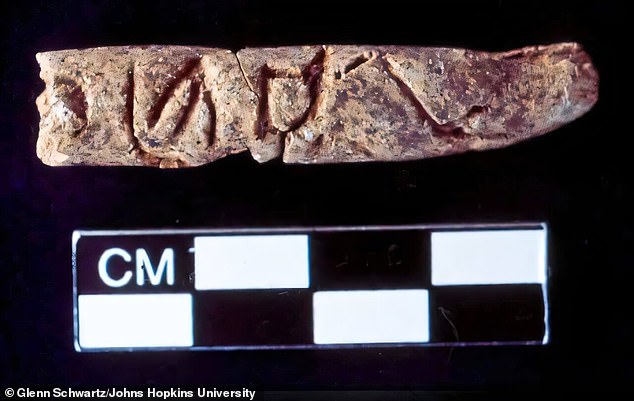For decades, it has been a common belief that the ancient Egyptians were responsible for the first alphabet.
Now, a shocking find challenges this assumption, pushing back the age of the first known alphabetic writing by about 500 years.
Researchers at Johns Hopkins University in Baltimore, Maryland, say small cylinders made of clay are engraved with the oldest known alphabetic text.
The finger-length cylinders were found at Tell Umm-el Marra, an ancient city located in present-day northwestern Syria, which was once a bustling crossroads of two trade routes.
Carbon dating techniques reveal that the objects date back 4,400 years, to 2400 BC. C., which predates any other known alphabetic writing by approximately 500 years.
The cylinders may have been labels for something, perhaps drinking vessels containing wine that needed to be transported.
The writing could denote names or descriptions of properties, according to Glenn Schwartz, a professor of archeology at Johns Hopkins University.
However, the academic admits that he “can only speculate” exactly what the writing says.
During an excavation in the ancient city of Umm el-Marra, clay objects about the size of fingers were discovered. The engraved symbols may be part of the oldest known alphabet.
Before the alphabet, humans relied on hieroglyphics, according to Professor Schwartz, who found the cylinders in 2004.
“Alphabetic writing changed the way people lived, thought and communicated,” he said.
“This new discovery shows that people were experimenting with new communication technologies much earlier and in a different place than we had imagined.”
With colleagues from the University of Amsterdam, the professor co-led a 16-year archaeological excavation at Tell Umm-el Marra, one of the oldest cities in the Near East, located at a crossroads of two trade routes.
At Umm-el Marra, archaeologists discovered tombs dating back to the Early Bronze Age, a period spanning roughly 3,500 to 2,000 BC.
One of the best-preserved tombs contained six skeletons, gold and silver jewelry, kitchen utensils, a spearhead, and intact ceramic vessels.
Next to the pottery were four “lightly fired” clay cylinders or tubes with what appeared to be alphabetic writing on the top.
Now, researchers have used carbon-14 dating, a scientific method that can accurately determine the age of organic materials up to 60,000 years old.

Using carbon-14 dating techniques, the researchers confirmed the ages of the clay cylinders: around 2400 BC. C., or about 4400 years ago.

The finger-length cylinders were found at Tell Umm-el Marra, an ancient city located in present-day northwestern Syria, which was once a bustling crossroads of two trade routes.
The decay rate of carbon-14, an isotope of carbon, is constant and easy to measure, making it ideal for providing age estimates for anything older than 300 years.
The technique confirmed the ages of the tombs, artifacts and the writing, which predates other alphabetic writings by half a century.
“Previously, scholars thought that the alphabet was invented in or around Egypt sometime after 1900 BC,” Professor Schwartz said.
“But our artifacts are older and from a different area on the map, suggesting that the alphabet may have a completely different origin story than we thought.”
As for the nature of the cylinders, the academic thinks that they may have been early and more primitive versions of today’s labels.
He suspects they might have been hung on the containers to identify something about them, whether their contents, their owner, or their origin or destination.
“The cylinders were perforated, so I imagine a string tying them to another object to act as a tag,” Professor Schwartz said.
‘Perhaps they detail the contents of a container, or perhaps where the container came from, or who it belonged to.

At Umm-el Marra, archaeologists discovered tombs dating back to the Early Bronze Age, a period spanning approximately 3500 to 2000 BC. One of the best-preserved tombs contained six skeletons, gold and silver jewelry, utensils kitchen, a spearhead and intact ceramic vessels.
“Without means to translate the writing, we can only speculate.”
The generally accepted theory of the origin of the alphabet dates back to a group of illiterate miners in ancient Egypt in 1900 BC.
Inspired by the hieroglyphs they saw around them, migrant workers forged letters for their own Semitic language based on the shapes of Egyptian glyphs.
It eventually spread to the Levant (the eastern Mediterranean region of western Asia) around 1300 BC
From there, it began to spread throughout the Mediterranean and eventually became the Greek and Latin alphabets.
Before any alphabet, early writing systems, such as hieroglyphics, were “extremely difficult to learn”, according to Professor Schwartz.
“There were thousands of symbols used in very complicated ways, which meant that only a very small group of people could learn to write or read,” he said.
“The invention of the alphabet meant that, in theory, a much larger number of people could learn to read and write and ultimately led to the democratization of writing.

In 2006, Egyptologist Orly Goldwasser argued that symbols (pictured) on artifacts unearthed in a Sinai temple in 1905 are prototypes of the letters we use to write today.
“And of course it’s the system that all Western European writing systems used because the Greeks, who borrowed the Semitic alphabet system, used it to write their own language.”
Professor Schwartz has long publicized the discovery of the cylinders, which were found in one of the site’s Early Bronze Age layers.
But carbon dating offers more conclusive evidence that alphabetic writing began 500 years earlier than previously believed.
Professor Schwartz will share details of his discovery on Thursday (November 21) at the annual meeting of the American Society for Foreign Research at the Hilton Boston Park Plaza, Massachusetts.



